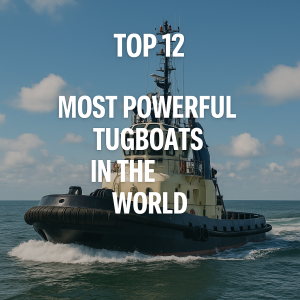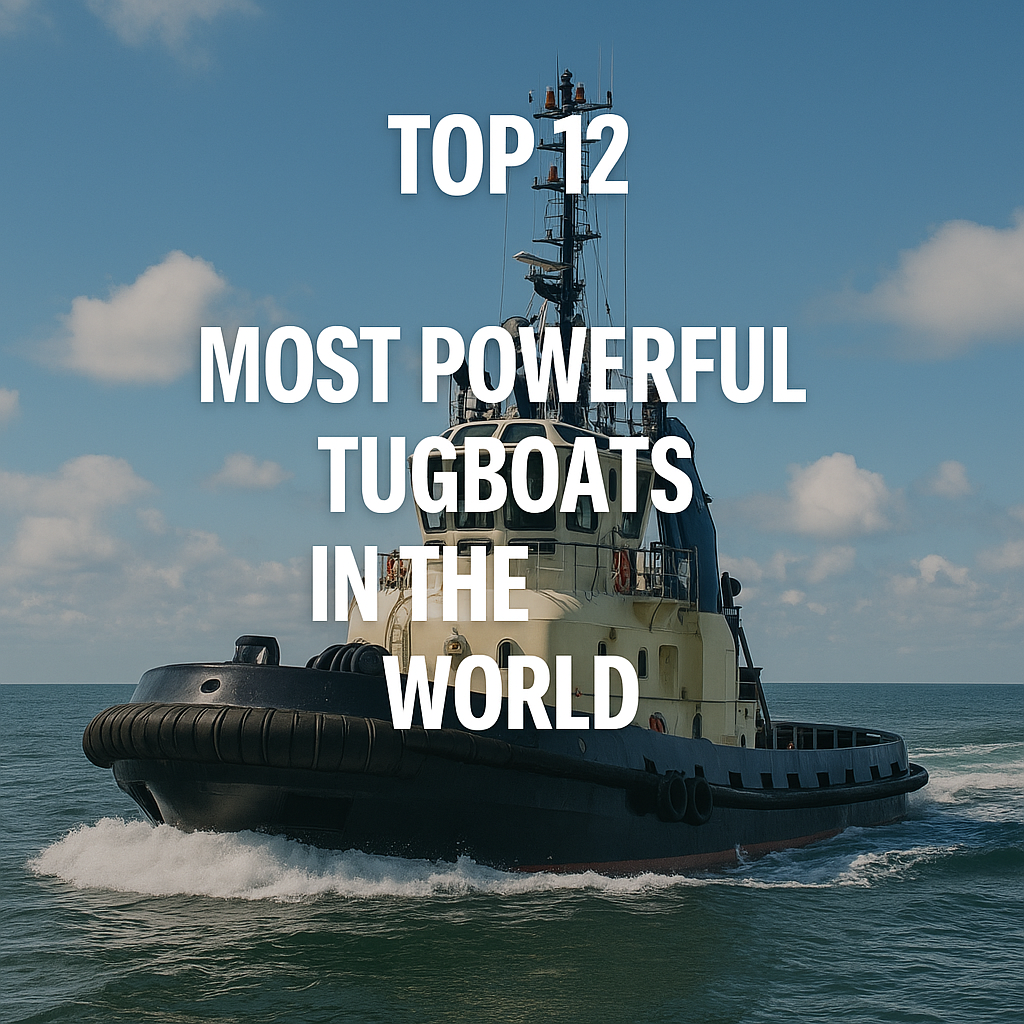Explore the top 12 most powerful tugboats that dominate global ports and offshore operations. Discover their technologies, capabilities, and the critical role they play in maritime logistics.
Why Powerful Tugboats Matter in Modern Maritime Operations
In the world of maritime logistics, power isn’t just a metric—it’s a necessity. Tugboats, though compact compared to the ships they assist, are some of the most powerful vessels at sea. Tasked with towing massive tankers, guiding container ships through narrow ports, and assisting offshore oil rigs in extreme weather, these boats are engineered for raw strength and precise maneuverability.
Modern tugboats must operate in environments ranging from Arctic ice fields to congested harbors like Rotterdam and Singapore. As ships have grown to over 400 meters in length and carry hundreds of thousands of tonnes of cargo, tugboats have evolved into high-powered machines capable of producing over 300 tonnes of bollard pull—essentially the maritime equivalent of horsepower.
According to the International Maritime Organization (IMO), port safety and maneuvering efficiency heavily rely on the quality of towage services, which is why tugboat innovations are directly linked to the safety of seafarers, ships, and cargo.

Top 12 Most Powerful Tugboats in Operation Today
1. Island Victory (Norway)
Bollard Pull: 477 tonnes
Owner: Island Offshore
Launched in 2020, Island Victory is classified as an anchor-handling tug supply vessel (AHTS). It’s one of the most powerful of its kind, supporting offshore oil fields in the harsh conditions of the North Sea. With hybrid propulsion and a diesel-electric system, it combines power with efficiency.
2. Far Samson (Norway)
Bollard Pull: 423 tonnes
Owner: Solstad Offshore
Far Samson was the world’s strongest tug at launch in 2009 and has maintained its elite status. Designed to handle subsea construction and anchor-handling duties, it uses Rolls-Royce marine technology and complies with DNV standards.
3. ALP Striker (Netherlands)
Bollard Pull: 306 tonnes
Owner: ALP Maritime Services
A long-distance towing specialist, ALP Striker can sail 45 days without refueling. It supports floating production storage and offloading (FPSO) units and semi-submersibles. With Wärtsilä engines and dynamic positioning (DP2), it leads in both range and power.
4. AHTS Bourbon Orca (France/Norway)
Bollard Pull: ~280 tonnes
Owner: Bourbon Offshore
This revolutionary X-Bow vessel is designed to reduce slamming and fuel consumption. Bourbon Orca is lauded for its safety and efficiency in anchor-handling and subsea operations in the North Atlantic.
5. Posh Champion (Singapore)
Bollard Pull: 270 tonnes
Owner: PACC Offshore Services Holdings (POSH)
POSH Champion is a deepwater towage and salvage tug, supporting FPSO and rig towage missions across Asia. It’s equipped with azimuth stern drives and an advanced firefighting system (FiFi II).
6. Resolve Monarch (USA)
Bollard Pull: 261 tonnes
Owner: Resolve Marine
This versatile tug is used for emergency response and deep-sea towing. It’s a critical asset in salvage operations and has assisted in disaster zones, including hurricane-hit Gulf regions.
7. Boka Falcon (Netherlands)
Bollard Pull: ~250 tonnes
Owner: Boskalis
A top-tier AHTS vessel designed for offshore wind and oil projects. It features high-capacity winches and can handle anchor mooring for floating wind turbines—a growing application area.
8. Aiviq (USA)
Bollard Pull: 200 tonnes
Owner: Edison Chouest Offshore
Built for Arctic operations, Aiviq is ice-classed and supports U.S. offshore oil exploration in Alaska. It boasts redundant propulsion and dynamic positioning systems that allow precision in remote, icy waters.
9. Ocean Tundra (Canada)
Bollard Pull: 180 tonnes
Owner: Ocean Group
This Canadian hybrid tug operates in icy waters along the St. Lawrence River. It’s designed for both escort and icebreaking, merging power with environmental compliance.
10. ASD Tug 3213 (Global Fleet)
Bollard Pull: 85–120 tonnes
Builder: Damen Shipyards
This model is used worldwide by operators like Svitzer and Kotug. It features azimuth stern drives and excellent maneuverability, making it ideal for container terminals and LNG ports.
11. Rotortug RT Evolution (Netherlands)
Bollard Pull: ~85 tonnes
Owner: Kotug International
This tug has a patented triple Z-drive configuration, giving it unparalleled precision in escort duties. It also features hybrid propulsion, contributing to reduced emissions.
12. Smit Lamnalco SL IBO (West Africa)
Bollard Pull: ~100 tonnes
Owner: Smit Lamnalco
Deployed for terminal support in Equatorial Guinea, this tug excels in LNG berth operations. It meets stringent OCIMF and ISGOTT standards, ensuring both power and safety.
–
Key Technologies Powering Modern Tugboats
Hybrid and Electric Propulsion
Ships like Ocean Tundra and RT Evolution utilize hybrid systems combining diesel and battery power. This reduces fuel consumption and emissions—important as IMO’s 2023 decarbonization mandates become enforceable.
Dynamic Positioning (DP) Systems
Common on AHTS tugs like ALP Striker and Aiviq, DP systems use sensors and GPS to maintain exact positioning during high-risk operations like FPSO installation.
Azimuth Thrusters and Z-Drives
Z-drive and ASD configurations allow tugboats to spin 360° on their axis, providing unmatched maneuverability in tight port spaces.
Firefighting Systems (FiFi I and II)
Modern tugboats often double as emergency responders. Systems like FiFi II allow them to combat shipboard and terminal fires.
Challenges and Solutions in Tugboat Operations
Environmental Regulations
Tugboats are under pressure to reduce their carbon footprint. Solutions include LNG fuel, hybrid-electric systems, and hull optimization technologies to reduce drag.
Harbor Congestion
Mega ports like Shanghai and Rotterdam are getting busier. Tugboats must be more agile, better coordinated, and tech-enabled.
Solution: Integration with port digital twins and traffic management systems, enabling predictive scheduling and route optimization.
Weather and Sea Conditions
Operations in Arctic or typhoon-prone waters require specialized ice-class vessels and high bollard pull ratings to ensure vessel safety.
Solution: Reinforced hulls, icebreaking features, and dynamic load monitoring ensure performance under pressure.
Case Study: Island Victory Assists with Subsea Installation in the Barents Sea
In 2022, Island Victory played a crucial role in installing a subsea oil pipeline in Norway’s Barents Sea. Operating in freezing temperatures and unpredictable swells, the vessel deployed 450 tonnes of bollard pull to position a 12,000-tonne module. Using advanced DP3 systems and integrated weather tracking, the mission was completed without delays or environmental incidents. It showcased the critical importance of tugboat precision and power in offshore construction.
FAQ: Most Powerful Tugboats
1. What is bollard pull in tugboats?
Bollard pull measures the pulling power of a tugboat in tonnes. It’s akin to horsepower for road vehicles.
2. What makes a tugboat powerful?
A combination of engine capacity, propulsion design (like Z-drives), and hull form contribute to bollard pull and maneuverability.
3. Are powerful tugboats used only in ports?
No. Many are used offshore for anchor handling, oil rig support, and emergency towing missions.
4. What is the average power of a port tugboat?
Typical harbor tugs range from 40 to 90 tonnes of bollard pull, while offshore tugs may exceed 300 tonnes.
5. How are tugboats adapting to environmental regulations?
Many incorporate hybrid or LNG propulsion and follow IMO Tier III emissions standards.
6. Who regulates tugboat operations?
Flag states, port authorities, classification societies like ABS or DNV, and international organizations like IMO and IACS regulate tug safety and compliance.
Conclusion: Small in Size, Massive in Power
The world’s most powerful tugboats are silent giants of the maritime world. They might not carry cargo, but without them, global trade would grind to a halt. Whether guiding tankers into ports, supporting offshore wind installations, or executing Arctic rescues, these vessels represent engineering excellence and operational necessity.
As ship sizes and environmental concerns grow, tugboats will continue to evolve—stronger, smarter, and cleaner. For maritime professionals and students alike, understanding tugboat technology is vital to grasping the full scale of global logistics.
References
-
International Maritime Organization (IMO). (2023). MARPOL & Emission Reduction Strategy. https://www.imo.org
-
Damen Shipyards. (2024). ASD Tug Series. https://www.damen.com
-
Island Offshore. (2024). Vessel Specs: Island Victory. https://www.islandoffshore.com
-
MarineTraffic. (2024). Live Vessel Tracker. https://www.marinetraffic.com
-
Wärtsilä. (2023). Hybrid Tug Solutions. https://www.wartsila.com
-
Lloyd’s List Intelligence. (2023). Towage Sector Analysis. https://lloydslist.maritimeintelligence.informa.com
-
Royal Institution of Naval Architects (RINA). (2023). Tug Technology & Innovations. https://www.rina.org.uk

